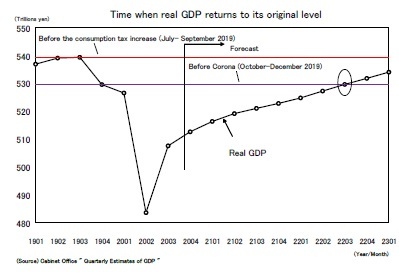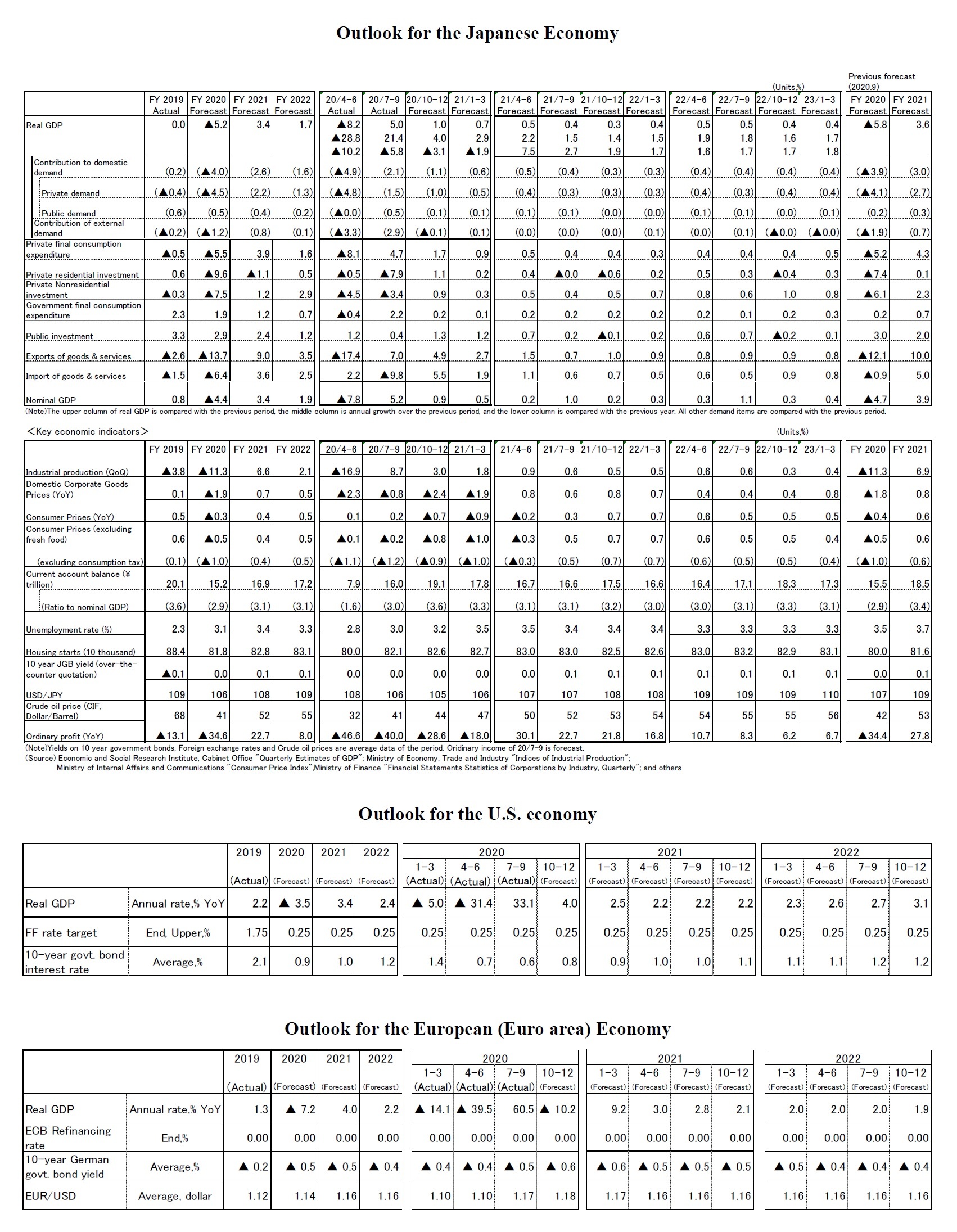- シンクタンクならニッセイ基礎研究所 >
- 経済 >
- 経済予測・経済見通し >
- Japan's Economic Outlook for FY 2020–2022
2020年11月25日
文字サイズ
- 小
- 中
- 大
2. The real growth rate is expected to be -5.2% in FY 2020, 3.4% in FY 2021 and 1.7% in FY 2022.
(Real GDP will exceed its most recent peak in FY 2023)
Growth in the July–September quarter of 2020 was significantly positive following the lifting of the state of emergency, but the pace is likely to slow significantly in the October–December quarter of 2020.
Real GDP growth rates in the United States and the euro area in the July–September quarter of 2020 were 33.1% and 60.5% on an annualized basis from the previous quarter, respectively. Recently, however, the number of people infected with the novel coronavirus has increased, and the trend toward lockdown has spread again in Europe. In response, real GDP growth in the euro area is expected to turn negative again in the October–December quarter of 2020. Exports of goods and services in the GDP statistics rose 7.0% in the July–September quarter, but in the October–December quarter of 2020, growth will decline, particularly to the U.S. and the euro area. On the other hand, imports, which fell by 9.8% in the July–September quarter from the previous quarter, are likely to increase in the October–December quarter after that. Contributions of external demand to the real GDP growth in the October–December quarter of 2020 is expected to be slightly negative.
Private consumption, which was the main cause of the substantial positive growth in the July–September quarter, is expected to slow down in the October–December quarter as the growth in service consumption—supported by measures to stimulate demand, such as the Go To campaign—is increasing, while the growth in consumption of goods is slowing due to the end of pent-up demand.
Although capital investment, which has been declining since the economic downturn, will increase in the October–December quarter of 2020 for the first time in 3 quarters, it is highly likely that the pace of recovery will remain moderate for the time being due to deterioration in corporate earnings and high uncertainty over the future.
Real GDP in the July–September quarter of 2020 grew at an annualized rate of 21.4%. It will decrease to 4.0% in the October–December quarter of 2020, and it will slow down in 2021. However, since the economy is in the process of normalization, it is expected that the growth rate will clearly exceed the potential growth rate for the time being. However, if a new spread of the novel coronavirus occurs and the declaration of a state of emergency is reissued, economic growth would be negative again and a slowdown in the economy would be inevitable.
Growth in the July–September quarter of 2020 was significantly positive following the lifting of the state of emergency, but the pace is likely to slow significantly in the October–December quarter of 2020.
Real GDP growth rates in the United States and the euro area in the July–September quarter of 2020 were 33.1% and 60.5% on an annualized basis from the previous quarter, respectively. Recently, however, the number of people infected with the novel coronavirus has increased, and the trend toward lockdown has spread again in Europe. In response, real GDP growth in the euro area is expected to turn negative again in the October–December quarter of 2020. Exports of goods and services in the GDP statistics rose 7.0% in the July–September quarter, but in the October–December quarter of 2020, growth will decline, particularly to the U.S. and the euro area. On the other hand, imports, which fell by 9.8% in the July–September quarter from the previous quarter, are likely to increase in the October–December quarter after that. Contributions of external demand to the real GDP growth in the October–December quarter of 2020 is expected to be slightly negative.
Private consumption, which was the main cause of the substantial positive growth in the July–September quarter, is expected to slow down in the October–December quarter as the growth in service consumption—supported by measures to stimulate demand, such as the Go To campaign—is increasing, while the growth in consumption of goods is slowing due to the end of pent-up demand.
Although capital investment, which has been declining since the economic downturn, will increase in the October–December quarter of 2020 for the first time in 3 quarters, it is highly likely that the pace of recovery will remain moderate for the time being due to deterioration in corporate earnings and high uncertainty over the future.
Real GDP in the July–September quarter of 2020 grew at an annualized rate of 21.4%. It will decrease to 4.0% in the October–December quarter of 2020, and it will slow down in 2021. However, since the economy is in the process of normalization, it is expected that the growth rate will clearly exceed the potential growth rate for the time being. However, if a new spread of the novel coronavirus occurs and the declaration of a state of emergency is reissued, economic growth would be negative again and a slowdown in the economy would be inevitable.
 The pace of economic recovery is expected to remain moderate after a sharp drop, even if no strict action restrictions are imposed. This is because new lifestyles (securing social distance) will continue to restrain consumption of face-to-face services, and bankruptcies, unemployment, and declining corporate profits caused by the coronavirus disaster will exert downward pressure on future demand. In addition, in industries where demand has remained significantly depressed, the decline in supply capacity caused by the coronavirus disaster may contribute to a delay in future demand recovery. For example, in the accommodation industry, which has been strongly affected by the loss of inbound tourist demand, the number of guest rooms needed to accommodate foreign visitors has declined significantly due to a series of bankruptcies and downsizing of business, and this is likely to exert downward pressure on demand in the medium to long term.
The pace of economic recovery is expected to remain moderate after a sharp drop, even if no strict action restrictions are imposed. This is because new lifestyles (securing social distance) will continue to restrain consumption of face-to-face services, and bankruptcies, unemployment, and declining corporate profits caused by the coronavirus disaster will exert downward pressure on future demand. In addition, in industries where demand has remained significantly depressed, the decline in supply capacity caused by the coronavirus disaster may contribute to a delay in future demand recovery. For example, in the accommodation industry, which has been strongly affected by the loss of inbound tourist demand, the number of guest rooms needed to accommodate foreign visitors has declined significantly due to a series of bankruptcies and downsizing of business, and this is likely to exert downward pressure on demand in the medium to long term.The real GDP growth rate is forecast to be minus 5.2% in FY 2020, 3.4% in FY 2021, and 1.7% in FY 2022. Real GDP levels will exceed pre-coronavirus levels (October–December quarter of 2019) in the July–September quarter of 2022, but will not return to the most recent peak before the consumption tax increase (July–September quarter of 2019) until 2023.
Please: The data contained in this report has been obtained and processed from various sources, and cannot be used to guarantee the accuracy or safety of the report. The purpose of this publication is to provide information, and the opinions and forecasts contained herein do not solicit the conclusion or termination of any contract.
(2020年11月25日「Weekly エコノミスト・レター」)
このレポートの関連カテゴリ

03-3512-1836
経歴
- ・ 1992年:日本生命保険相互会社
・ 1996年:ニッセイ基礎研究所へ
・ 2019年8月より現職
・ 2010年 拓殖大学非常勤講師(日本経済論)
・ 2012年~ 神奈川大学非常勤講師(日本経済論)
・ 2018年~ 統計委員会専門委員
斎藤 太郎のレポート
| 日付 | タイトル | 執筆者 | 媒体 |
|---|---|---|---|
| 2025/10/31 | 2025年7-9月期の実質GDP~前期比▲0.7%(年率▲2.7%)を予測~ | 斎藤 太郎 | Weekly エコノミスト・レター |
| 2025/10/31 | 鉱工業生産25年9月-7-9月期の生産は2四半期ぶりの減少も、均してみれば横ばいで推移 | 斎藤 太郎 | 経済・金融フラッシュ |
| 2025/10/31 | 雇用関連統計25年9月-女性の正規雇用比率が50%に近づく | 斎藤 太郎 | 経済・金融フラッシュ |
| 2025/10/30 | 潜在成長率は変えられる-日本経済の本当の可能性 | 斎藤 太郎 | 基礎研レポート |
新着記事
-
2025年11月07日
フィリピンGDP(25年7-9月期)~民間消費の鈍化で4.0%成長に減速、電子部品輸出は堅調 -
2025年11月07日
次回の利上げは一体いつか?~日銀金融政策を巡る材料点検 -
2025年11月07日
個人年金の改定についての技術的なアドバイス(欧州)-EIOPAから欧州委員会への回答 -
2025年11月07日
中国の貿易統計(25年10月)~輸出、輸入とも悪化。対米輸出は減少が続く -
2025年11月07日
英国金融政策(11月MPC公表)-2会合連続の据え置きで利下げペースは鈍化
お知らせ
-
2025年07月01日
News Release
-
2025年06月06日
News Release
-
2025年04月02日
News Release
【Japan's Economic Outlook for FY 2020–2022】【シンクタンク】ニッセイ基礎研究所は、保険・年金・社会保障、経済・金融・不動産、暮らし・高齢社会、経営・ビジネスなどの各専門領域の研究員を抱え、様々な情報提供を行っています。
Japan's Economic Outlook for FY 2020–2022のレポート Topへ




















 各種レポート配信をメールでお知らせ。読み逃しを防ぎます!
各種レポート配信をメールでお知らせ。読み逃しを防ぎます!




